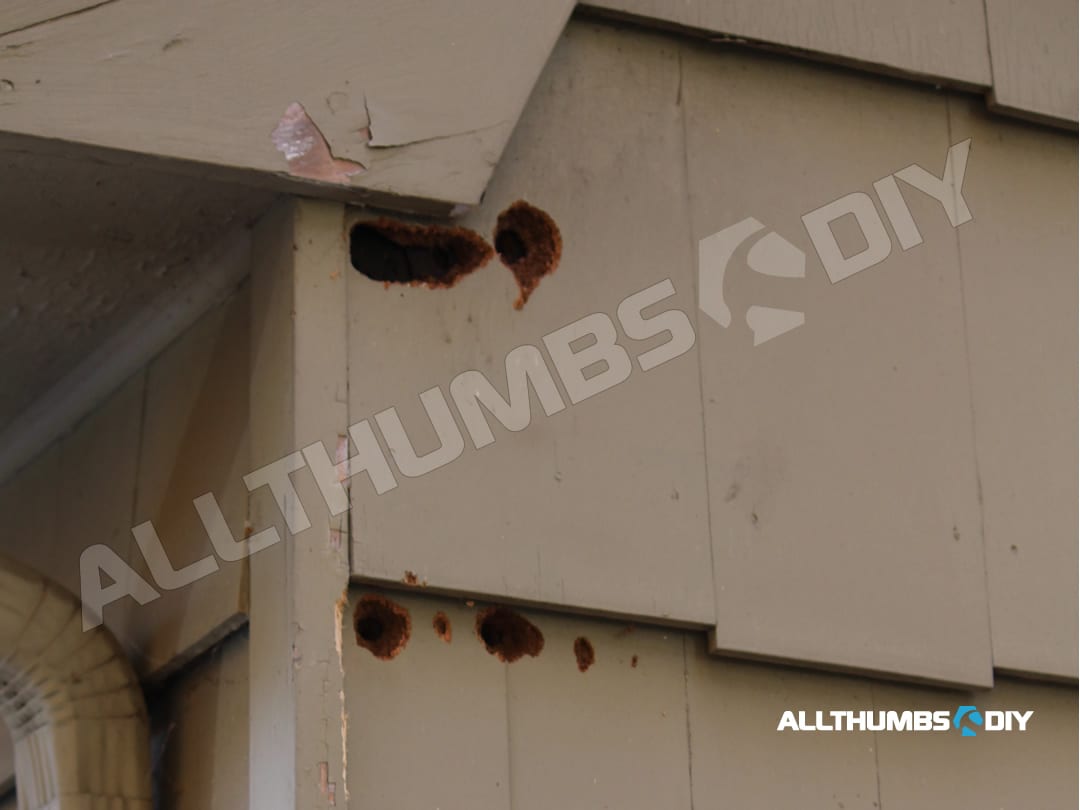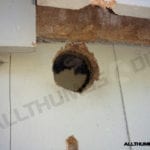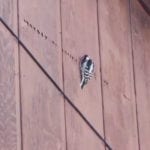
First of all, let me say that I love nature and all that comes with it. I think woodpeckers are an integral part of the ecosystem because not only do they eat bugs, they provide second-hand homes (i.e. abandoned ness) to a host of other species (i.e. small birds, owls and small animals like squirrels).
Now how could such useful animal drive a grown, mature adult (me) into a maddening, vengeful and sometimes irrational lunatic?
Thoughts of trapping, poisoning or shooting (with a pellet gun or sling shot) ran through my head with disgusting glee (don’t worry. My story has a happy ending for both of us).
| Warning |
|---|
| Woodpeckers are classified as migratory, non-game birds and are protected by the Federal Migratory Bird Treaty Act. When warranted, woodpeckers other than the endangered species (red-cockaded and ivory-billed woodpeckers) can be killed but only under a permit issued by the Law Enforcement Division of the US Fish and Wildlife Service. Woodpeckers are also commonly protected under state laws which may fall under separate jurisdiction (i.e. another permit) |
Driving Me Mad
It all started last fall when I heard a constant pecking sound against my cedar shingled house over month and a half (I work from home on most day). Initially, I thought it was a bunch of acorns falling on the roof. When the sound became more consistent, I knew something was pecking at my house.
To make the long story short, I made a mistake of not shooing it away fast enough. Due to cold weather, I actually allowed my woodpecker to drill a 3” wide hole and make a nest out of it.
Although I was little concerned when it started to rip out the pink insulation, I wanted to be as accommodating as possible. What a fool I was for believing this non-sense.
And you know what, it worked for a season! I mean it was pretty noise in the morning because the hole was in my master bedroom wall and those baby woodpeckers wanted food all the time but otherwise, it no longer pecked my house.
However, this peace did not last.
The following spring, the woodpecker (not sure if it’s one of the parents or babies) resumed right back into pecking. All. Over. The. House. Again.
And after a year of providing free “room” to this woodpecker family, I felt slighted.
I mean it was bad enough with its hammering noises but now the woodpecker was doing some considerable damage to my house.
Could it be because they drilled holes on my siding pretty much everywhere? Or could it be because when I chased it away, it simply flew to a nearby branch and played hide-and-seek with me, like it was taunting me?
But a woodpecker who has taunted me for over a year was enough to make me into an irrational lunatic who thought of taking revenge by coming up with such plan as poisoning or shooting it with a pellet gun (to fellow nature lovers, relax. My sanity returned just in time before doing anything I might regret later).
What is Pecking at my house?
Woodpeckers are known to have excellent eye sights (they are definitely NOT color blind as some may suggest). They also have a keen sense of hearing (some theorize they can hear electrical wires humming inside walls which may simulate insect buzzing). But their sense of smell is poor.
According to Audubon Society, these four woodpeckers are the most common ones that are known to drill and drum on houses:
- Downy woodpecker (P. pubescens; this is the one that is driving me crazy);
- Hairy woodpecker (Picoides villosus);
- Pileated woodpecker; (Dryocopus pileatus);
- Northern flicker (Colaptes auratus);
Generally, damage to a building involves only one or two birds, but it may involve up to six or eight during a season. Most of the damage occurs from February through June, which corresponds with the breeding season and the period of territory establishment.
Pecking Purpose
To a woodpecker, wood siding on a house is really not that different than a tree, so it does make sense that a woodpecker would intentionally or mistakenly, find some unlucky homes for drilling and drumming.
I am sure it did not help that my house siding consists of cedar, painted in sage green.
So why to woodpeckers peck or beats its strong bill, into tree trunks, limbs and cedar siding? There are 3 central theories :
- Mating call / Protecting territory
- Looking for food (i.e. bugs like carpenter bees, carpenter ants, etc.)
- Nesting
Different Pecking Sounds
There are two distinct pecking sounds associated with these reasons.
- Drumming, rapid, fast machine-gun, tattooing sound
- Irregular “rat-tat-tat” tapping or rapping sound
The steady, loud and rapid pecking or drumming (also referenced as tattooing, tapping and rapping) sound is to communicate with other woodpeckers, usually associated with a mating call is used as a mating call to attract a mate or to announce its territory.
The resulting loud staccato noise pattern is created by repeatedly striking the tree bark (or cedar siding) like a jackhammer with their pointy beak.
| Woodpecker Anatomy |
|---|
| Woodpecker can peck a substrate with its bill approximately 18 times per second, lasting up to 2 seconds. That roughly equates to approximate speeds of 12 to 15 miles an hour! So how do they manage to keep their wits and not get headaches? It’s because their brains are held firmly in a case, which acts as a shock absorber. Their bodies also move in unison like a metronome, avoiding torque (rotational force) that would damage their brains. The human brain on the other hand, is encased in a sac of fluid (cerebro spinal fluid or CSF) which does nothing to prevent a brain from sloshing around inside the skull (i.e. concussion) |
By the way, the pecking sound can travel quite far (up to half a mile) so it can be fairly loud when you are sitting inside your house.
Mating / Protecting Territory
Downy woodpeckers primarily known to drum from February through July.
Drumming rates are usually highest prior to nesting, lower during nesting, and increase again after young leave the nest. They tend to drum more in the morning. Females and males drum equally.
If a downy loses a mate, they drum from frequently than paired birds.
Drumming may be a response to longer day length, which in turn probably stimulates hormone production. It may help establish and maintain breeding territory, to attract a mate, to stimulate females, guard mates, maintain contact, strengthen pair bonds, and solicit sex. Pairs may engage in duets.
They usually peck at hollow branches, but if you are unlucky, they may use your gutter or siding as a substitute.
Food
Irregular pecking (sounds like “rat-tat-tat”, tapping or drilling) is done while searching for food or excavating a nest hole (you can visit Stony Brook University – Woodpecker page for sound examples)
Tapping is done at a slower rate than drumming, and is associated mainly with feeding, but may be done at a nest site. Tapping might provide information about the quality of wood.
According to Audubon Society, if you are seeing holes drilled or chipped away, it may mean you have insects living in your external boards that the woodpecker found.
When woodpeckers attack siding, they are NOT seeking material to line their nests. Unlike many small cavity nesters, woodpeckers generally do not line their nesting cavities with found materials.
It is not uncommon to have carpenter bees which will drill holes into wood and tunnel through, laying eggs that are not visible from the outside.
Woodpeckers, with their keen sense of hearing, may open up the tunnels from the outside and eat the hatched larvae. (you can also try yourself by placing your hand or ear to the wall and hearing the hum and feeling the vibration of the colony).
Once the hole is made, the woodpecker’s long tongue shoots into the hole and spears insects on a barb at the tip of its tongue. A sticky saliva on the tongue also helps trap the food.
The woodpecker’s toes flair out, enabling it to climb the trunks of trees and stop and feed at any point.
A stiff spine in its tail helps support the woodpecker on the tree trunk. Although it eats mainly insects, berries, nuts, and fruit are also part of the woodpecker’s diet.
Nesting / Roosting
Finally woodpeckers may find your wood siding as an attractive and easily excavated site for a nest or roost hole.
If the woodpecker seems to be making a round hole big enough for it to enter (and in my case pull put the insulation), he or she is getting her home ready. If you do not stop this by blocking using some type of barrier, it will be hard to get ti leave.
Final Words
Now that I have a good understanding of how woodpecker operate, I am going to try various solutions to see if I can deploy an effective solution. You can read more about my experiments at How Do I Stop A Woodpecker from Damaging My House (click here)
If you found this article to be useful, would you please do me a small favor and sign up for my newsletter? The signup form is found on the upper right hand corner of your screen.





Larry Borshard
Thursday 2nd of June 2022
Thanks for the info! And I haven't even begun to explore all the additional links yet. Yours was the first article I found mentioning the speculation that some houses may have some kind of buzzing (electrical or mechanical) that simulates insect activity and attracts woodpeckers. I'm trying to recall where I heard that before, maybe from my neighbor complaining why a woodpecker was drumming on their house and not ours, although theirs had signs of past or present carpenter bees. Question: You say it may be possible to hear the hum and feel the vibration of "the colony." It seems that carpenter bees are more solitary, although no doubt there could be a few in the same area if there is good food supply (insect infestation). Do you think carpenter bees have actual colonies? Thanks again for a lot of great info and an endearing story!
kevin
Monday 13th of June 2022
Hi Larry,
Thank you for your kind words! I am happy to report that I no longer have any woodpecker issues....both bird houses are taken up by a family of squirrels!